Personality and Social Psychology: PSYC 1211 Assignment 3 Analysis
VerifiedAdded on 2022/08/21
|9
|2803
|24
Homework Assignment
AI Summary
This assignment, completed for a Psychology course, delves into various aspects of personality and social psychology. Part A analyzes the results of a Big Five personality test, comparing them to another individual and discussing factors affecting accuracy. Part B examines self-actualization through the lens of Abraham Maslow and Carl Rodgers, comparing and contrasting their theories. Part C explores obedience to authority, social order, and civil disobedience, discussing the illusions of social change versus objective change and the role of civil disobedience in society. Part D focuses on reducing prejudice, examining systemic prejudice against African Americans, the application of therapeutic approaches, and the use of systemic thinking to understand bullying and suicide. The assignment provides detailed discussions and examples related to each topic, offering a comprehensive overview of key psychological concepts.
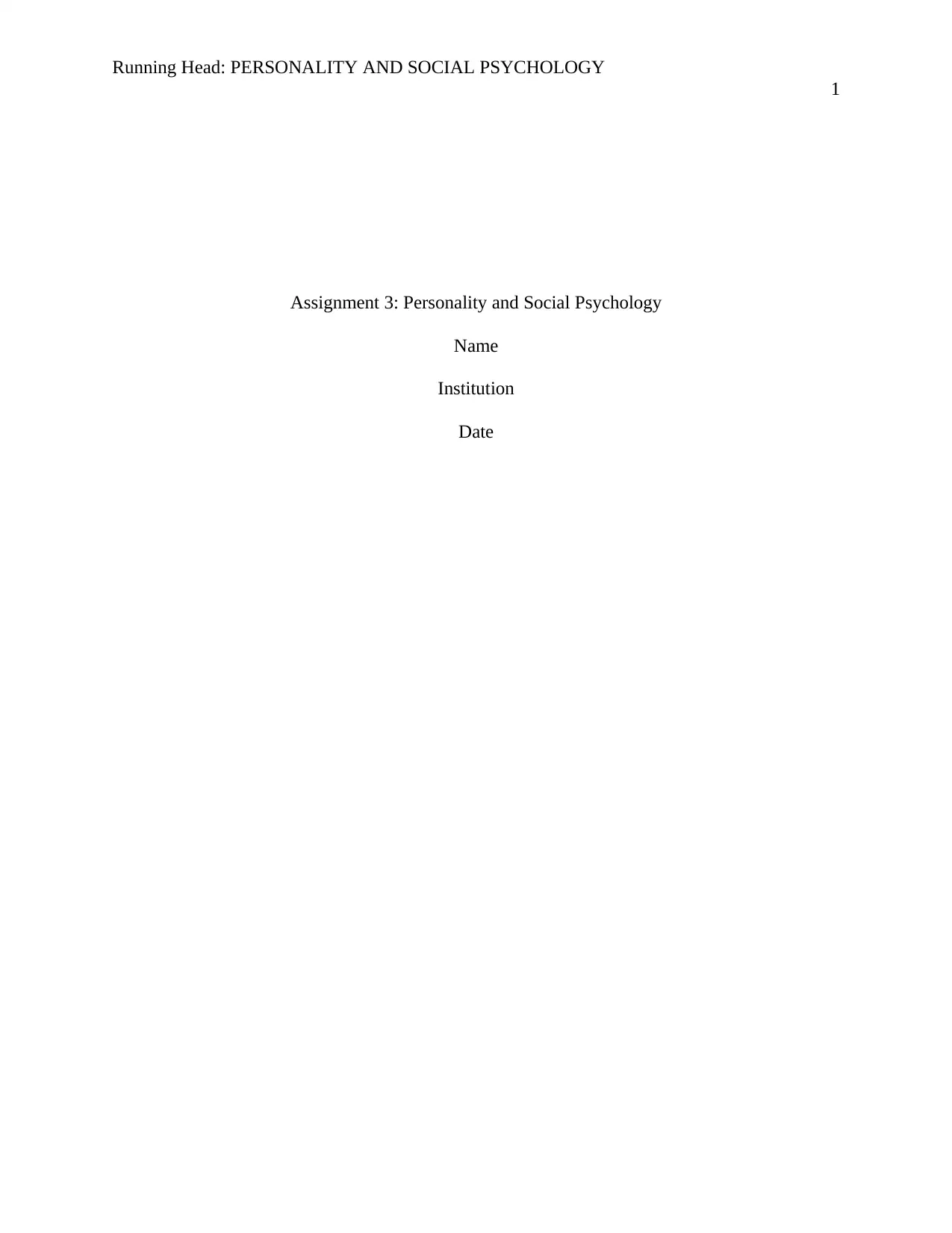
Running Head: PERSONALITY AND SOCIAL PSYCHOLOGY
1
Assignment 3: Personality and Social Psychology
Name
Institution
Date
1
Assignment 3: Personality and Social Psychology
Name
Institution
Date
Paraphrase This Document
Need a fresh take? Get an instant paraphrase of this document with our AI Paraphraser
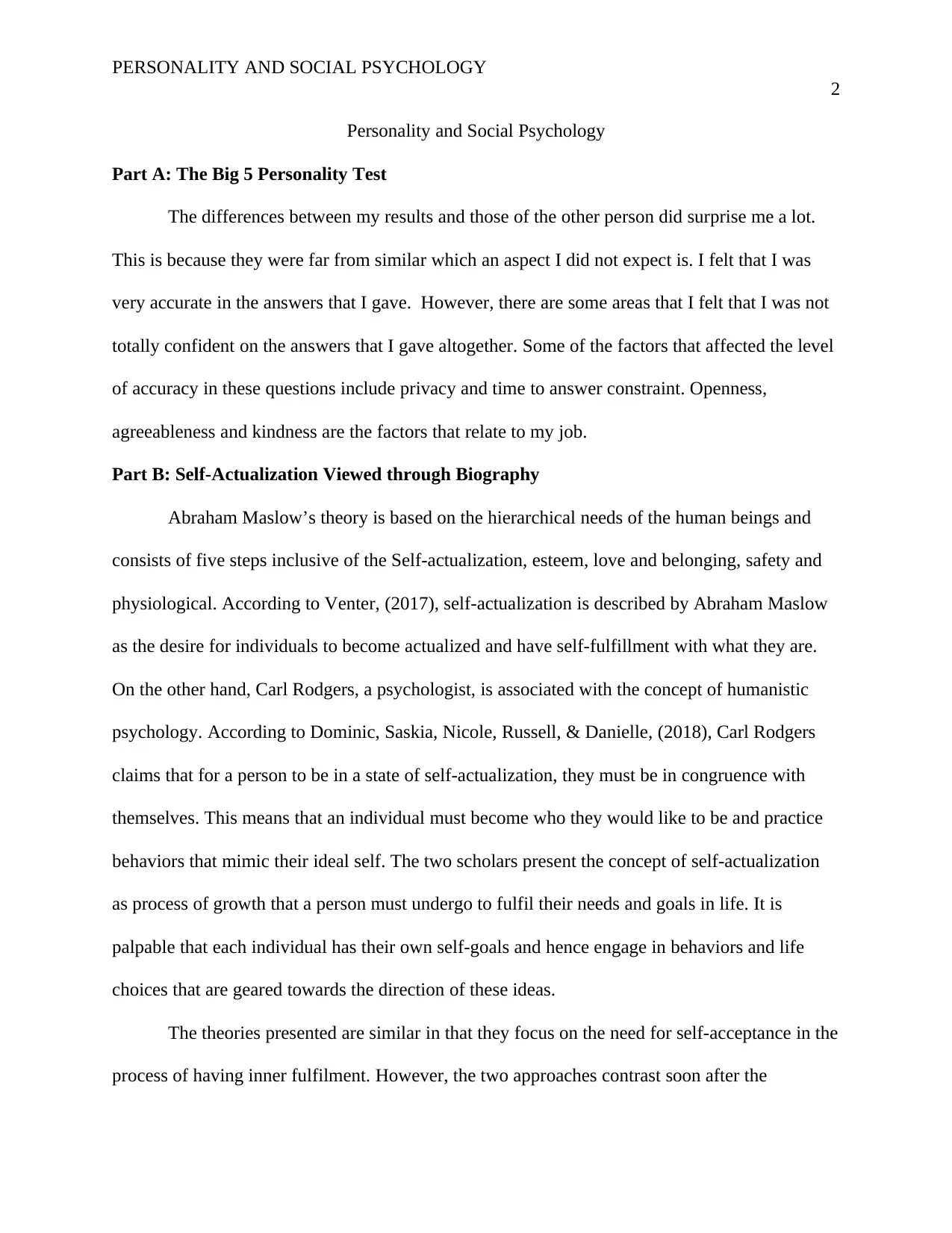
PERSONALITY AND SOCIAL PSYCHOLOGY
2
Personality and Social Psychology
Part A: The Big 5 Personality Test
The differences between my results and those of the other person did surprise me a lot.
This is because they were far from similar which an aspect I did not expect is. I felt that I was
very accurate in the answers that I gave. However, there are some areas that I felt that I was not
totally confident on the answers that I gave altogether. Some of the factors that affected the level
of accuracy in these questions include privacy and time to answer constraint. Openness,
agreeableness and kindness are the factors that relate to my job.
Part B: Self-Actualization Viewed through Biography
Abraham Maslow’s theory is based on the hierarchical needs of the human beings and
consists of five steps inclusive of the Self-actualization, esteem, love and belonging, safety and
physiological. According to Venter, (2017), self-actualization is described by Abraham Maslow
as the desire for individuals to become actualized and have self-fulfillment with what they are.
On the other hand, Carl Rodgers, a psychologist, is associated with the concept of humanistic
psychology. According to Dominic, Saskia, Nicole, Russell, & Danielle, (2018), Carl Rodgers
claims that for a person to be in a state of self-actualization, they must be in congruence with
themselves. This means that an individual must become who they would like to be and practice
behaviors that mimic their ideal self. The two scholars present the concept of self-actualization
as process of growth that a person must undergo to fulfil their needs and goals in life. It is
palpable that each individual has their own self-goals and hence engage in behaviors and life
choices that are geared towards the direction of these ideas.
The theories presented are similar in that they focus on the need for self-acceptance in the
process of having inner fulfilment. However, the two approaches contrast soon after the
2
Personality and Social Psychology
Part A: The Big 5 Personality Test
The differences between my results and those of the other person did surprise me a lot.
This is because they were far from similar which an aspect I did not expect is. I felt that I was
very accurate in the answers that I gave. However, there are some areas that I felt that I was not
totally confident on the answers that I gave altogether. Some of the factors that affected the level
of accuracy in these questions include privacy and time to answer constraint. Openness,
agreeableness and kindness are the factors that relate to my job.
Part B: Self-Actualization Viewed through Biography
Abraham Maslow’s theory is based on the hierarchical needs of the human beings and
consists of five steps inclusive of the Self-actualization, esteem, love and belonging, safety and
physiological. According to Venter, (2017), self-actualization is described by Abraham Maslow
as the desire for individuals to become actualized and have self-fulfillment with what they are.
On the other hand, Carl Rodgers, a psychologist, is associated with the concept of humanistic
psychology. According to Dominic, Saskia, Nicole, Russell, & Danielle, (2018), Carl Rodgers
claims that for a person to be in a state of self-actualization, they must be in congruence with
themselves. This means that an individual must become who they would like to be and practice
behaviors that mimic their ideal self. The two scholars present the concept of self-actualization
as process of growth that a person must undergo to fulfil their needs and goals in life. It is
palpable that each individual has their own self-goals and hence engage in behaviors and life
choices that are geared towards the direction of these ideas.
The theories presented are similar in that they focus on the need for self-acceptance in the
process of having inner fulfilment. However, the two approaches contrast soon after the
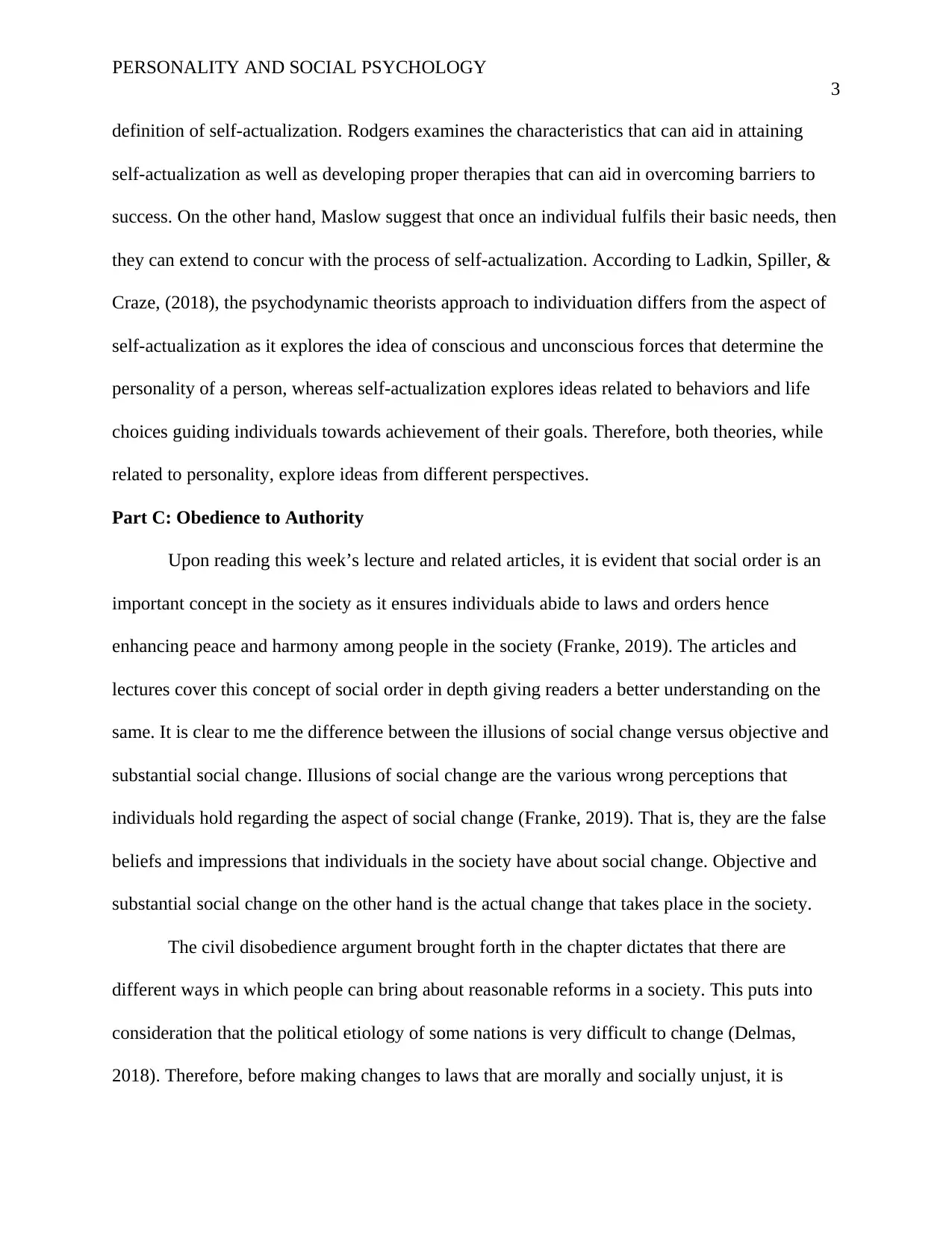
PERSONALITY AND SOCIAL PSYCHOLOGY
3
definition of self-actualization. Rodgers examines the characteristics that can aid in attaining
self-actualization as well as developing proper therapies that can aid in overcoming barriers to
success. On the other hand, Maslow suggest that once an individual fulfils their basic needs, then
they can extend to concur with the process of self-actualization. According to Ladkin, Spiller, &
Craze, (2018), the psychodynamic theorists approach to individuation differs from the aspect of
self-actualization as it explores the idea of conscious and unconscious forces that determine the
personality of a person, whereas self-actualization explores ideas related to behaviors and life
choices guiding individuals towards achievement of their goals. Therefore, both theories, while
related to personality, explore ideas from different perspectives.
Part C: Obedience to Authority
Upon reading this week’s lecture and related articles, it is evident that social order is an
important concept in the society as it ensures individuals abide to laws and orders hence
enhancing peace and harmony among people in the society (Franke, 2019). The articles and
lectures cover this concept of social order in depth giving readers a better understanding on the
same. It is clear to me the difference between the illusions of social change versus objective and
substantial social change. Illusions of social change are the various wrong perceptions that
individuals hold regarding the aspect of social change (Franke, 2019). That is, they are the false
beliefs and impressions that individuals in the society have about social change. Objective and
substantial social change on the other hand is the actual change that takes place in the society.
The civil disobedience argument brought forth in the chapter dictates that there are
different ways in which people can bring about reasonable reforms in a society. This puts into
consideration that the political etiology of some nations is very difficult to change (Delmas,
2018). Therefore, before making changes to laws that are morally and socially unjust, it is
3
definition of self-actualization. Rodgers examines the characteristics that can aid in attaining
self-actualization as well as developing proper therapies that can aid in overcoming barriers to
success. On the other hand, Maslow suggest that once an individual fulfils their basic needs, then
they can extend to concur with the process of self-actualization. According to Ladkin, Spiller, &
Craze, (2018), the psychodynamic theorists approach to individuation differs from the aspect of
self-actualization as it explores the idea of conscious and unconscious forces that determine the
personality of a person, whereas self-actualization explores ideas related to behaviors and life
choices guiding individuals towards achievement of their goals. Therefore, both theories, while
related to personality, explore ideas from different perspectives.
Part C: Obedience to Authority
Upon reading this week’s lecture and related articles, it is evident that social order is an
important concept in the society as it ensures individuals abide to laws and orders hence
enhancing peace and harmony among people in the society (Franke, 2019). The articles and
lectures cover this concept of social order in depth giving readers a better understanding on the
same. It is clear to me the difference between the illusions of social change versus objective and
substantial social change. Illusions of social change are the various wrong perceptions that
individuals hold regarding the aspect of social change (Franke, 2019). That is, they are the false
beliefs and impressions that individuals in the society have about social change. Objective and
substantial social change on the other hand is the actual change that takes place in the society.
The civil disobedience argument brought forth in the chapter dictates that there are
different ways in which people can bring about reasonable reforms in a society. This puts into
consideration that the political etiology of some nations is very difficult to change (Delmas,
2018). Therefore, before making changes to laws that are morally and socially unjust, it is
⊘ This is a preview!⊘
Do you want full access?
Subscribe today to unlock all pages.

Trusted by 1+ million students worldwide
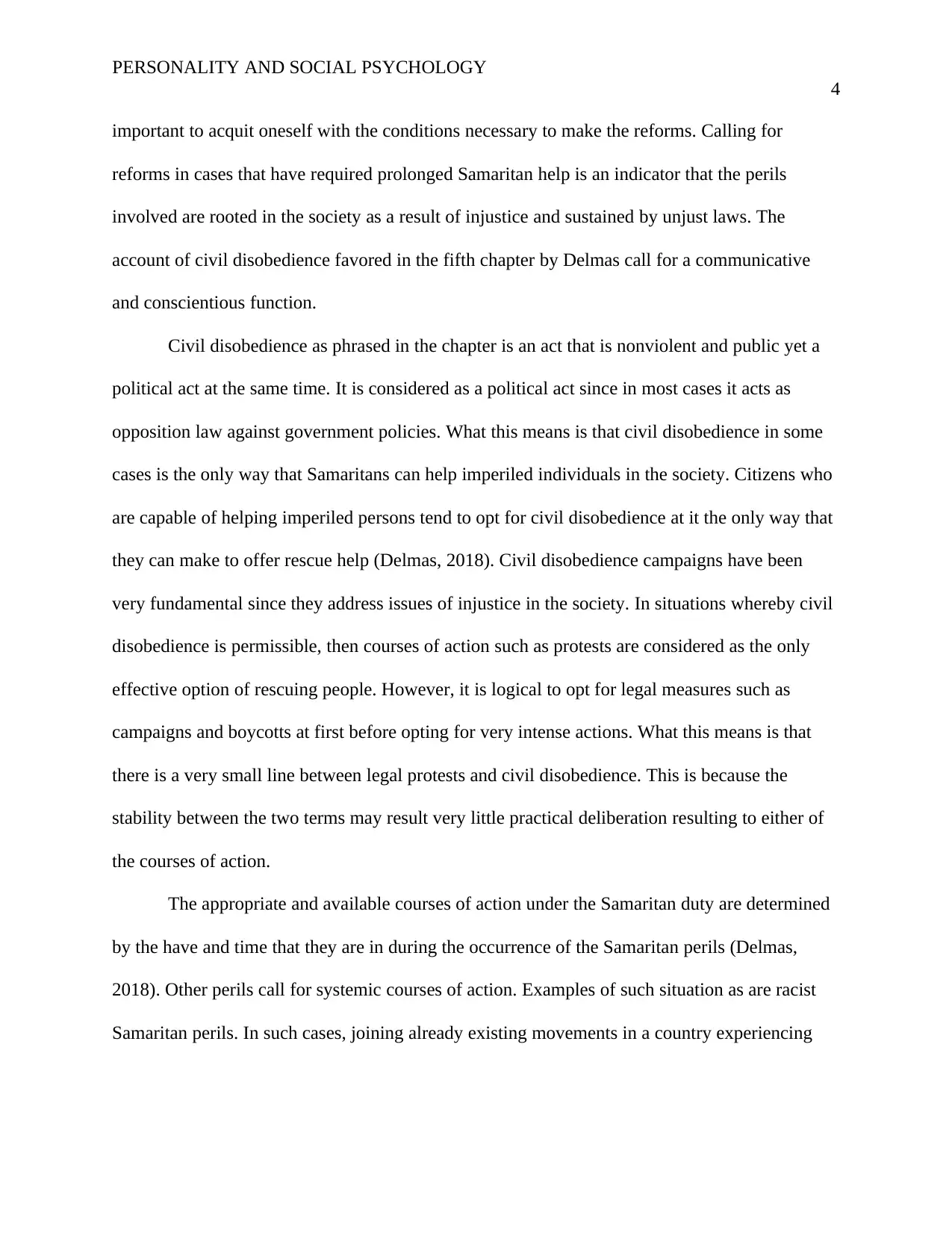
PERSONALITY AND SOCIAL PSYCHOLOGY
4
important to acquit oneself with the conditions necessary to make the reforms. Calling for
reforms in cases that have required prolonged Samaritan help is an indicator that the perils
involved are rooted in the society as a result of injustice and sustained by unjust laws. The
account of civil disobedience favored in the fifth chapter by Delmas call for a communicative
and conscientious function.
Civil disobedience as phrased in the chapter is an act that is nonviolent and public yet a
political act at the same time. It is considered as a political act since in most cases it acts as
opposition law against government policies. What this means is that civil disobedience in some
cases is the only way that Samaritans can help imperiled individuals in the society. Citizens who
are capable of helping imperiled persons tend to opt for civil disobedience at it the only way that
they can make to offer rescue help (Delmas, 2018). Civil disobedience campaigns have been
very fundamental since they address issues of injustice in the society. In situations whereby civil
disobedience is permissible, then courses of action such as protests are considered as the only
effective option of rescuing people. However, it is logical to opt for legal measures such as
campaigns and boycotts at first before opting for very intense actions. What this means is that
there is a very small line between legal protests and civil disobedience. This is because the
stability between the two terms may result very little practical deliberation resulting to either of
the courses of action.
The appropriate and available courses of action under the Samaritan duty are determined
by the have and time that they are in during the occurrence of the Samaritan perils (Delmas,
2018). Other perils call for systemic courses of action. Examples of such situation as are racist
Samaritan perils. In such cases, joining already existing movements in a country experiencing
4
important to acquit oneself with the conditions necessary to make the reforms. Calling for
reforms in cases that have required prolonged Samaritan help is an indicator that the perils
involved are rooted in the society as a result of injustice and sustained by unjust laws. The
account of civil disobedience favored in the fifth chapter by Delmas call for a communicative
and conscientious function.
Civil disobedience as phrased in the chapter is an act that is nonviolent and public yet a
political act at the same time. It is considered as a political act since in most cases it acts as
opposition law against government policies. What this means is that civil disobedience in some
cases is the only way that Samaritans can help imperiled individuals in the society. Citizens who
are capable of helping imperiled persons tend to opt for civil disobedience at it the only way that
they can make to offer rescue help (Delmas, 2018). Civil disobedience campaigns have been
very fundamental since they address issues of injustice in the society. In situations whereby civil
disobedience is permissible, then courses of action such as protests are considered as the only
effective option of rescuing people. However, it is logical to opt for legal measures such as
campaigns and boycotts at first before opting for very intense actions. What this means is that
there is a very small line between legal protests and civil disobedience. This is because the
stability between the two terms may result very little practical deliberation resulting to either of
the courses of action.
The appropriate and available courses of action under the Samaritan duty are determined
by the have and time that they are in during the occurrence of the Samaritan perils (Delmas,
2018). Other perils call for systemic courses of action. Examples of such situation as are racist
Samaritan perils. In such cases, joining already existing movements in a country experiencing
Paraphrase This Document
Need a fresh take? Get an instant paraphrase of this document with our AI Paraphraser
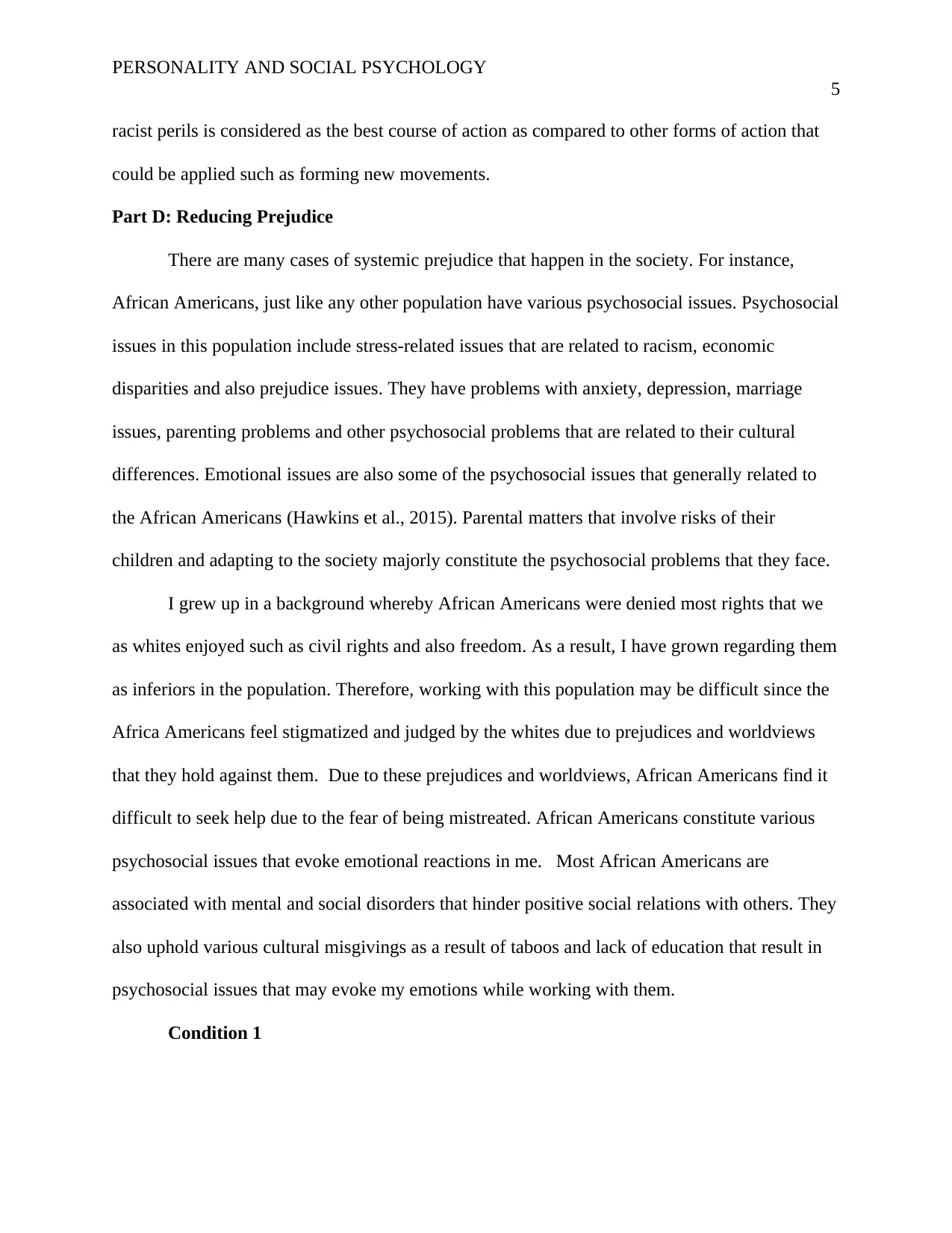
PERSONALITY AND SOCIAL PSYCHOLOGY
5
racist perils is considered as the best course of action as compared to other forms of action that
could be applied such as forming new movements.
Part D: Reducing Prejudice
There are many cases of systemic prejudice that happen in the society. For instance,
African Americans, just like any other population have various psychosocial issues. Psychosocial
issues in this population include stress-related issues that are related to racism, economic
disparities and also prejudice issues. They have problems with anxiety, depression, marriage
issues, parenting problems and other psychosocial problems that are related to their cultural
differences. Emotional issues are also some of the psychosocial issues that generally related to
the African Americans (Hawkins et al., 2015). Parental matters that involve risks of their
children and adapting to the society majorly constitute the psychosocial problems that they face.
I grew up in a background whereby African Americans were denied most rights that we
as whites enjoyed such as civil rights and also freedom. As a result, I have grown regarding them
as inferiors in the population. Therefore, working with this population may be difficult since the
Africa Americans feel stigmatized and judged by the whites due to prejudices and worldviews
that they hold against them. Due to these prejudices and worldviews, African Americans find it
difficult to seek help due to the fear of being mistreated. African Americans constitute various
psychosocial issues that evoke emotional reactions in me. Most African Americans are
associated with mental and social disorders that hinder positive social relations with others. They
also uphold various cultural misgivings as a result of taboos and lack of education that result in
psychosocial issues that may evoke my emotions while working with them.
Condition 1
5
racist perils is considered as the best course of action as compared to other forms of action that
could be applied such as forming new movements.
Part D: Reducing Prejudice
There are many cases of systemic prejudice that happen in the society. For instance,
African Americans, just like any other population have various psychosocial issues. Psychosocial
issues in this population include stress-related issues that are related to racism, economic
disparities and also prejudice issues. They have problems with anxiety, depression, marriage
issues, parenting problems and other psychosocial problems that are related to their cultural
differences. Emotional issues are also some of the psychosocial issues that generally related to
the African Americans (Hawkins et al., 2015). Parental matters that involve risks of their
children and adapting to the society majorly constitute the psychosocial problems that they face.
I grew up in a background whereby African Americans were denied most rights that we
as whites enjoyed such as civil rights and also freedom. As a result, I have grown regarding them
as inferiors in the population. Therefore, working with this population may be difficult since the
Africa Americans feel stigmatized and judged by the whites due to prejudices and worldviews
that they hold against them. Due to these prejudices and worldviews, African Americans find it
difficult to seek help due to the fear of being mistreated. African Americans constitute various
psychosocial issues that evoke emotional reactions in me. Most African Americans are
associated with mental and social disorders that hinder positive social relations with others. They
also uphold various cultural misgivings as a result of taboos and lack of education that result in
psychosocial issues that may evoke my emotions while working with them.
Condition 1
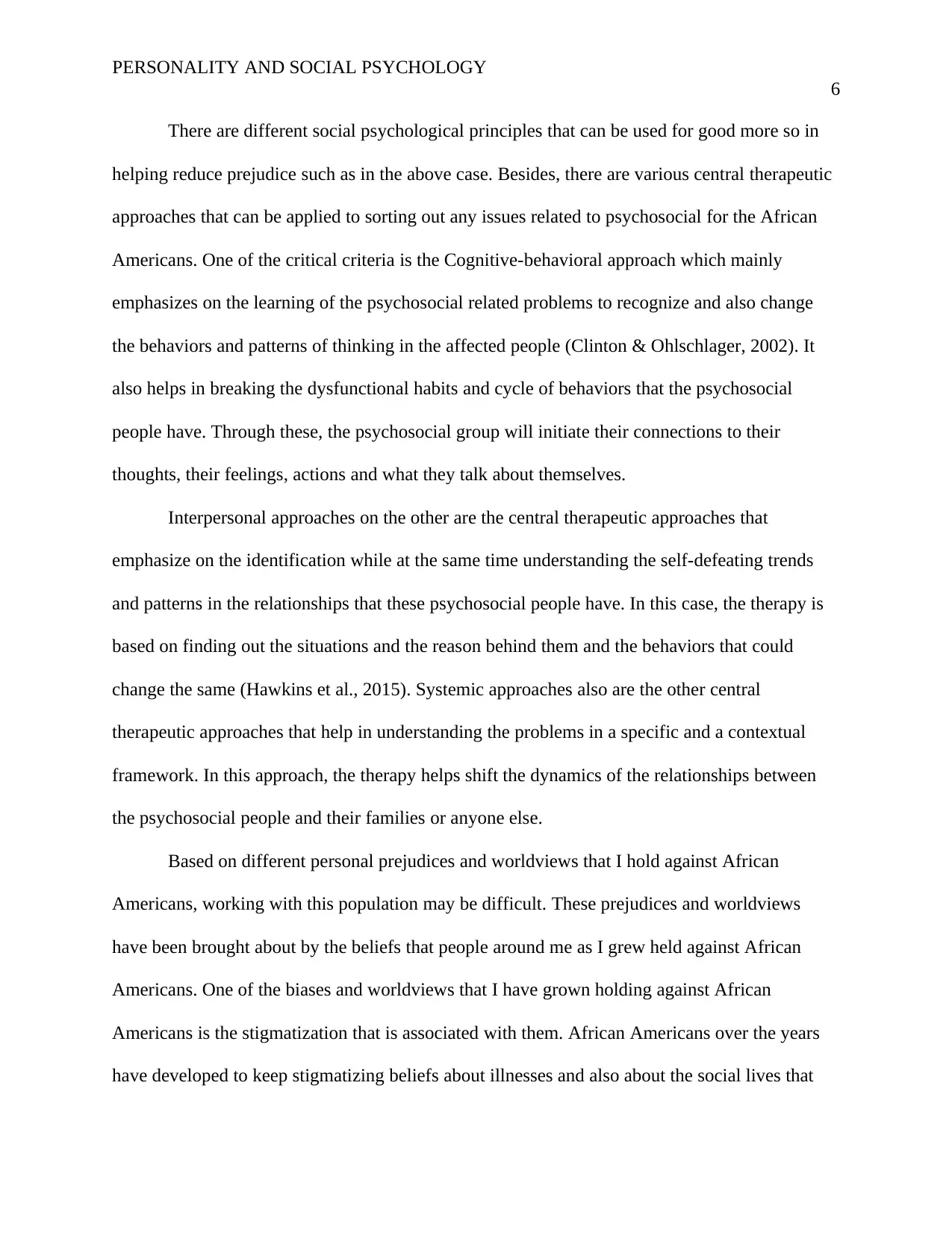
PERSONALITY AND SOCIAL PSYCHOLOGY
6
There are different social psychological principles that can be used for good more so in
helping reduce prejudice such as in the above case. Besides, there are various central therapeutic
approaches that can be applied to sorting out any issues related to psychosocial for the African
Americans. One of the critical criteria is the Cognitive-behavioral approach which mainly
emphasizes on the learning of the psychosocial related problems to recognize and also change
the behaviors and patterns of thinking in the affected people (Clinton & Ohlschlager, 2002). It
also helps in breaking the dysfunctional habits and cycle of behaviors that the psychosocial
people have. Through these, the psychosocial group will initiate their connections to their
thoughts, their feelings, actions and what they talk about themselves.
Interpersonal approaches on the other are the central therapeutic approaches that
emphasize on the identification while at the same time understanding the self-defeating trends
and patterns in the relationships that these psychosocial people have. In this case, the therapy is
based on finding out the situations and the reason behind them and the behaviors that could
change the same (Hawkins et al., 2015). Systemic approaches also are the other central
therapeutic approaches that help in understanding the problems in a specific and a contextual
framework. In this approach, the therapy helps shift the dynamics of the relationships between
the psychosocial people and their families or anyone else.
Based on different personal prejudices and worldviews that I hold against African
Americans, working with this population may be difficult. These prejudices and worldviews
have been brought about by the beliefs that people around me as I grew held against African
Americans. One of the biases and worldviews that I have grown holding against African
Americans is the stigmatization that is associated with them. African Americans over the years
have developed to keep stigmatizing beliefs about illnesses and also about the social lives that
6
There are different social psychological principles that can be used for good more so in
helping reduce prejudice such as in the above case. Besides, there are various central therapeutic
approaches that can be applied to sorting out any issues related to psychosocial for the African
Americans. One of the critical criteria is the Cognitive-behavioral approach which mainly
emphasizes on the learning of the psychosocial related problems to recognize and also change
the behaviors and patterns of thinking in the affected people (Clinton & Ohlschlager, 2002). It
also helps in breaking the dysfunctional habits and cycle of behaviors that the psychosocial
people have. Through these, the psychosocial group will initiate their connections to their
thoughts, their feelings, actions and what they talk about themselves.
Interpersonal approaches on the other are the central therapeutic approaches that
emphasize on the identification while at the same time understanding the self-defeating trends
and patterns in the relationships that these psychosocial people have. In this case, the therapy is
based on finding out the situations and the reason behind them and the behaviors that could
change the same (Hawkins et al., 2015). Systemic approaches also are the other central
therapeutic approaches that help in understanding the problems in a specific and a contextual
framework. In this approach, the therapy helps shift the dynamics of the relationships between
the psychosocial people and their families or anyone else.
Based on different personal prejudices and worldviews that I hold against African
Americans, working with this population may be difficult. These prejudices and worldviews
have been brought about by the beliefs that people around me as I grew held against African
Americans. One of the biases and worldviews that I have grown holding against African
Americans is the stigmatization that is associated with them. African Americans over the years
have developed to keep stigmatizing beliefs about illnesses and also about the social lives that
⊘ This is a preview!⊘
Do you want full access?
Subscribe today to unlock all pages.

Trusted by 1+ million students worldwide
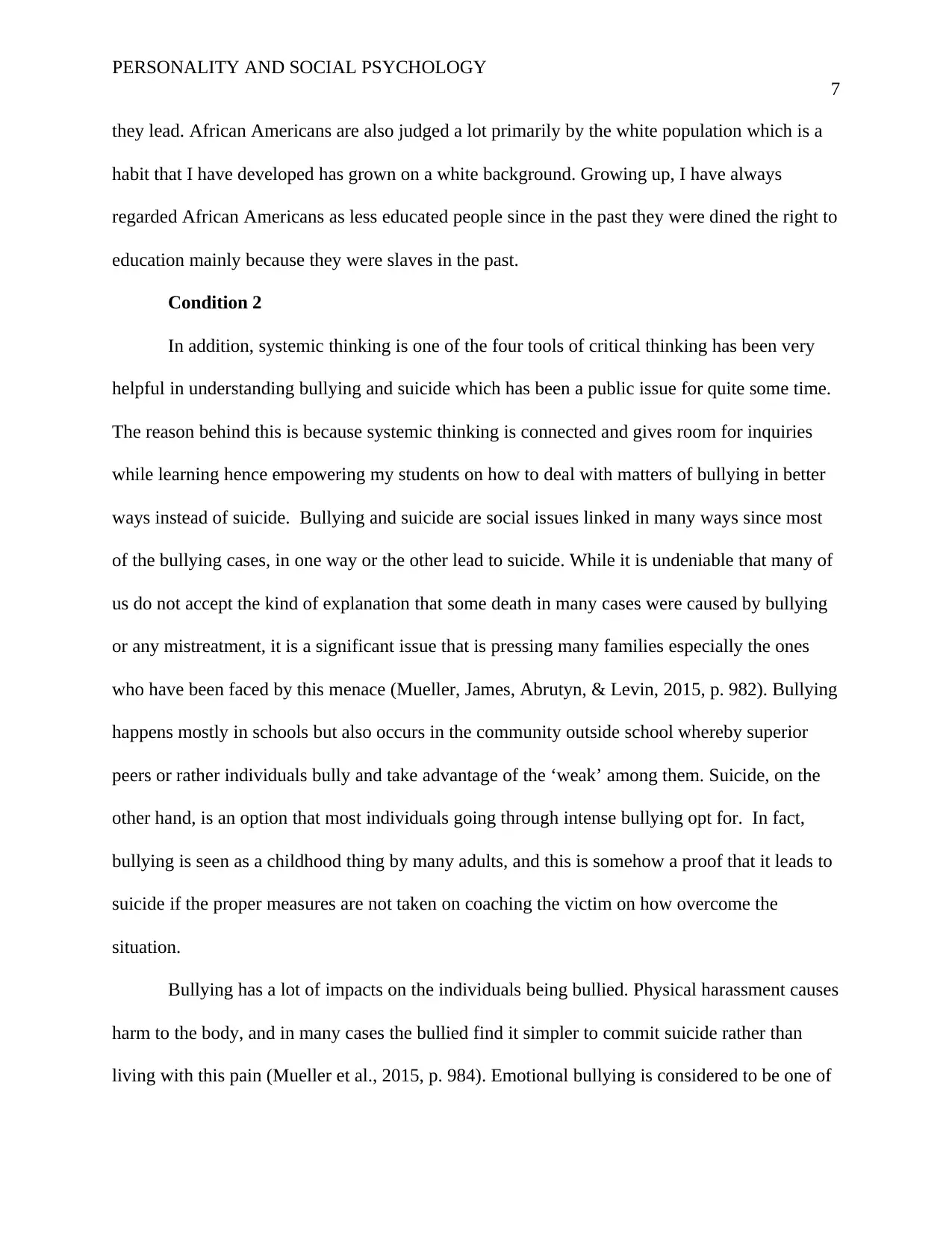
PERSONALITY AND SOCIAL PSYCHOLOGY
7
they lead. African Americans are also judged a lot primarily by the white population which is a
habit that I have developed has grown on a white background. Growing up, I have always
regarded African Americans as less educated people since in the past they were dined the right to
education mainly because they were slaves in the past.
Condition 2
In addition, systemic thinking is one of the four tools of critical thinking has been very
helpful in understanding bullying and suicide which has been a public issue for quite some time.
The reason behind this is because systemic thinking is connected and gives room for inquiries
while learning hence empowering my students on how to deal with matters of bullying in better
ways instead of suicide. Bullying and suicide are social issues linked in many ways since most
of the bullying cases, in one way or the other lead to suicide. While it is undeniable that many of
us do not accept the kind of explanation that some death in many cases were caused by bullying
or any mistreatment, it is a significant issue that is pressing many families especially the ones
who have been faced by this menace (Mueller, James, Abrutyn, & Levin, 2015, p. 982). Bullying
happens mostly in schools but also occurs in the community outside school whereby superior
peers or rather individuals bully and take advantage of the ‘weak’ among them. Suicide, on the
other hand, is an option that most individuals going through intense bullying opt for. In fact,
bullying is seen as a childhood thing by many adults, and this is somehow a proof that it leads to
suicide if the proper measures are not taken on coaching the victim on how overcome the
situation.
Bullying has a lot of impacts on the individuals being bullied. Physical harassment causes
harm to the body, and in many cases the bullied find it simpler to commit suicide rather than
living with this pain (Mueller et al., 2015, p. 984). Emotional bullying is considered to be one of
7
they lead. African Americans are also judged a lot primarily by the white population which is a
habit that I have developed has grown on a white background. Growing up, I have always
regarded African Americans as less educated people since in the past they were dined the right to
education mainly because they were slaves in the past.
Condition 2
In addition, systemic thinking is one of the four tools of critical thinking has been very
helpful in understanding bullying and suicide which has been a public issue for quite some time.
The reason behind this is because systemic thinking is connected and gives room for inquiries
while learning hence empowering my students on how to deal with matters of bullying in better
ways instead of suicide. Bullying and suicide are social issues linked in many ways since most
of the bullying cases, in one way or the other lead to suicide. While it is undeniable that many of
us do not accept the kind of explanation that some death in many cases were caused by bullying
or any mistreatment, it is a significant issue that is pressing many families especially the ones
who have been faced by this menace (Mueller, James, Abrutyn, & Levin, 2015, p. 982). Bullying
happens mostly in schools but also occurs in the community outside school whereby superior
peers or rather individuals bully and take advantage of the ‘weak’ among them. Suicide, on the
other hand, is an option that most individuals going through intense bullying opt for. In fact,
bullying is seen as a childhood thing by many adults, and this is somehow a proof that it leads to
suicide if the proper measures are not taken on coaching the victim on how overcome the
situation.
Bullying has a lot of impacts on the individuals being bullied. Physical harassment causes
harm to the body, and in many cases the bullied find it simpler to commit suicide rather than
living with this pain (Mueller et al., 2015, p. 984). Emotional bullying is considered to be one of
Paraphrase This Document
Need a fresh take? Get an instant paraphrase of this document with our AI Paraphraser
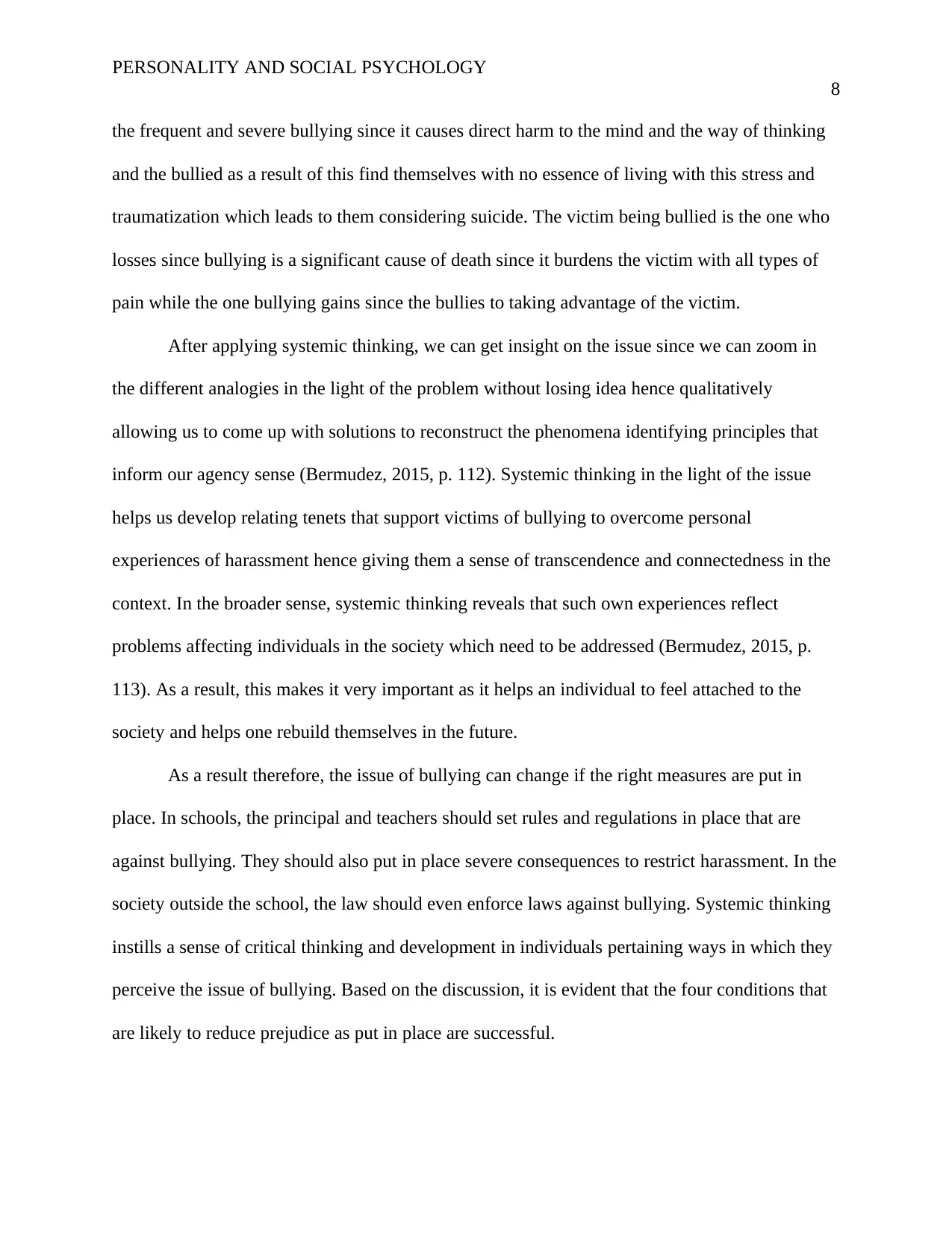
PERSONALITY AND SOCIAL PSYCHOLOGY
8
the frequent and severe bullying since it causes direct harm to the mind and the way of thinking
and the bullied as a result of this find themselves with no essence of living with this stress and
traumatization which leads to them considering suicide. The victim being bullied is the one who
losses since bullying is a significant cause of death since it burdens the victim with all types of
pain while the one bullying gains since the bullies to taking advantage of the victim.
After applying systemic thinking, we can get insight on the issue since we can zoom in
the different analogies in the light of the problem without losing idea hence qualitatively
allowing us to come up with solutions to reconstruct the phenomena identifying principles that
inform our agency sense (Bermudez, 2015, p. 112). Systemic thinking in the light of the issue
helps us develop relating tenets that support victims of bullying to overcome personal
experiences of harassment hence giving them a sense of transcendence and connectedness in the
context. In the broader sense, systemic thinking reveals that such own experiences reflect
problems affecting individuals in the society which need to be addressed (Bermudez, 2015, p.
113). As a result, this makes it very important as it helps an individual to feel attached to the
society and helps one rebuild themselves in the future.
As a result therefore, the issue of bullying can change if the right measures are put in
place. In schools, the principal and teachers should set rules and regulations in place that are
against bullying. They should also put in place severe consequences to restrict harassment. In the
society outside the school, the law should even enforce laws against bullying. Systemic thinking
instills a sense of critical thinking and development in individuals pertaining ways in which they
perceive the issue of bullying. Based on the discussion, it is evident that the four conditions that
are likely to reduce prejudice as put in place are successful.
8
the frequent and severe bullying since it causes direct harm to the mind and the way of thinking
and the bullied as a result of this find themselves with no essence of living with this stress and
traumatization which leads to them considering suicide. The victim being bullied is the one who
losses since bullying is a significant cause of death since it burdens the victim with all types of
pain while the one bullying gains since the bullies to taking advantage of the victim.
After applying systemic thinking, we can get insight on the issue since we can zoom in
the different analogies in the light of the problem without losing idea hence qualitatively
allowing us to come up with solutions to reconstruct the phenomena identifying principles that
inform our agency sense (Bermudez, 2015, p. 112). Systemic thinking in the light of the issue
helps us develop relating tenets that support victims of bullying to overcome personal
experiences of harassment hence giving them a sense of transcendence and connectedness in the
context. In the broader sense, systemic thinking reveals that such own experiences reflect
problems affecting individuals in the society which need to be addressed (Bermudez, 2015, p.
113). As a result, this makes it very important as it helps an individual to feel attached to the
society and helps one rebuild themselves in the future.
As a result therefore, the issue of bullying can change if the right measures are put in
place. In schools, the principal and teachers should set rules and regulations in place that are
against bullying. They should also put in place severe consequences to restrict harassment. In the
society outside the school, the law should even enforce laws against bullying. Systemic thinking
instills a sense of critical thinking and development in individuals pertaining ways in which they
perceive the issue of bullying. Based on the discussion, it is evident that the four conditions that
are likely to reduce prejudice as put in place are successful.
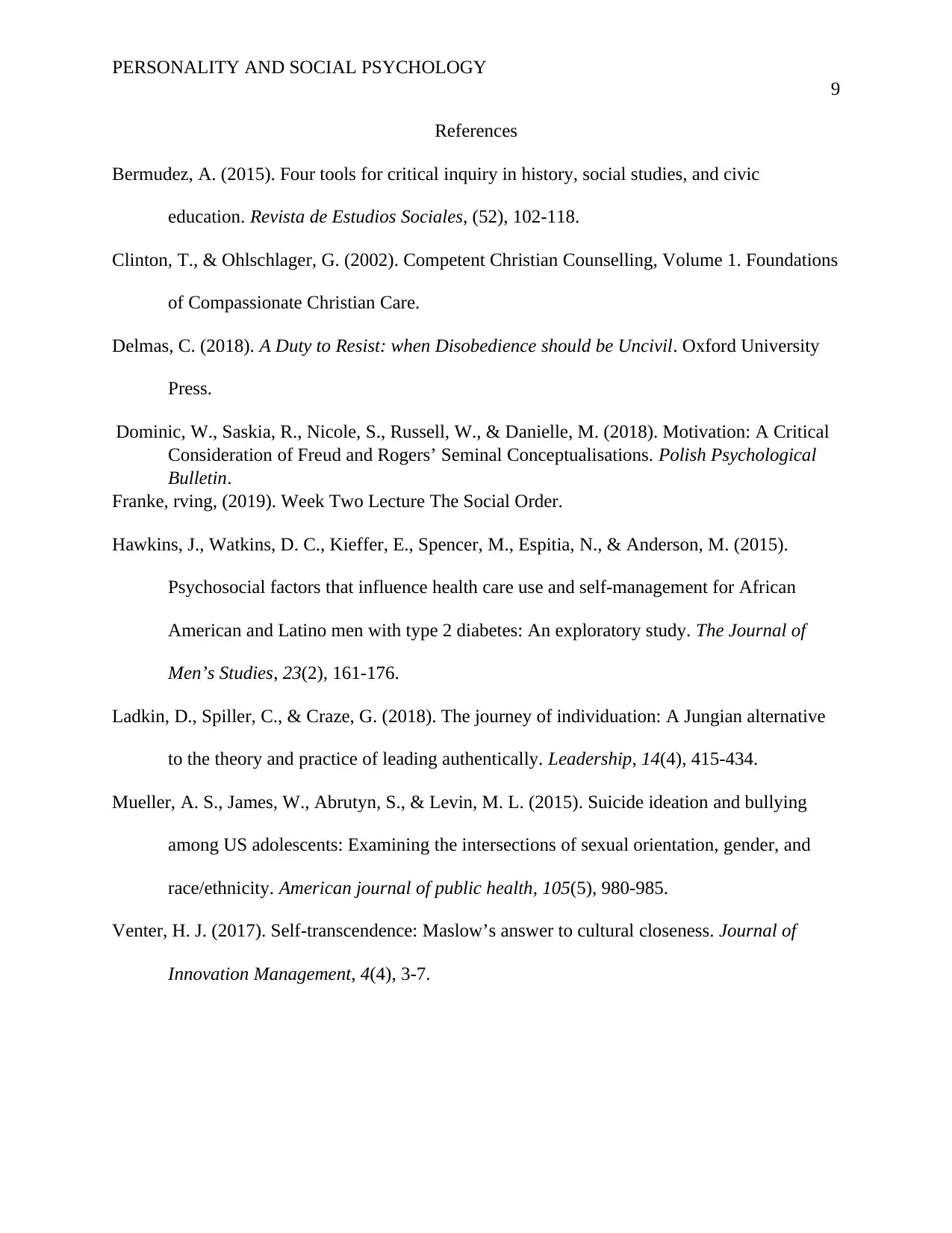
PERSONALITY AND SOCIAL PSYCHOLOGY
9
References
Bermudez, A. (2015). Four tools for critical inquiry in history, social studies, and civic
education. Revista de Estudios Sociales, (52), 102-118.
Clinton, T., & Ohlschlager, G. (2002). Competent Christian Counselling, Volume 1. Foundations
of Compassionate Christian Care.
Delmas, C. (2018). A Duty to Resist: when Disobedience should be Uncivil. Oxford University
Press.
Dominic, W., Saskia, R., Nicole, S., Russell, W., & Danielle, M. (2018). Motivation: A Critical
Consideration of Freud and Rogers’ Seminal Conceptualisations. Polish Psychological
Bulletin.
Franke, rving, (2019). Week Two Lecture The Social Order.
Hawkins, J., Watkins, D. C., Kieffer, E., Spencer, M., Espitia, N., & Anderson, M. (2015).
Psychosocial factors that influence health care use and self-management for African
American and Latino men with type 2 diabetes: An exploratory study. The Journal of
Men’s Studies, 23(2), 161-176.
Ladkin, D., Spiller, C., & Craze, G. (2018). The journey of individuation: A Jungian alternative
to the theory and practice of leading authentically. Leadership, 14(4), 415-434.
Mueller, A. S., James, W., Abrutyn, S., & Levin, M. L. (2015). Suicide ideation and bullying
among US adolescents: Examining the intersections of sexual orientation, gender, and
race/ethnicity. American journal of public health, 105(5), 980-985.
Venter, H. J. (2017). Self-transcendence: Maslow’s answer to cultural closeness. Journal of
Innovation Management, 4(4), 3-7.
9
References
Bermudez, A. (2015). Four tools for critical inquiry in history, social studies, and civic
education. Revista de Estudios Sociales, (52), 102-118.
Clinton, T., & Ohlschlager, G. (2002). Competent Christian Counselling, Volume 1. Foundations
of Compassionate Christian Care.
Delmas, C. (2018). A Duty to Resist: when Disobedience should be Uncivil. Oxford University
Press.
Dominic, W., Saskia, R., Nicole, S., Russell, W., & Danielle, M. (2018). Motivation: A Critical
Consideration of Freud and Rogers’ Seminal Conceptualisations. Polish Psychological
Bulletin.
Franke, rving, (2019). Week Two Lecture The Social Order.
Hawkins, J., Watkins, D. C., Kieffer, E., Spencer, M., Espitia, N., & Anderson, M. (2015).
Psychosocial factors that influence health care use and self-management for African
American and Latino men with type 2 diabetes: An exploratory study. The Journal of
Men’s Studies, 23(2), 161-176.
Ladkin, D., Spiller, C., & Craze, G. (2018). The journey of individuation: A Jungian alternative
to the theory and practice of leading authentically. Leadership, 14(4), 415-434.
Mueller, A. S., James, W., Abrutyn, S., & Levin, M. L. (2015). Suicide ideation and bullying
among US adolescents: Examining the intersections of sexual orientation, gender, and
race/ethnicity. American journal of public health, 105(5), 980-985.
Venter, H. J. (2017). Self-transcendence: Maslow’s answer to cultural closeness. Journal of
Innovation Management, 4(4), 3-7.
⊘ This is a preview!⊘
Do you want full access?
Subscribe today to unlock all pages.

Trusted by 1+ million students worldwide
1 out of 9
Related Documents
Your All-in-One AI-Powered Toolkit for Academic Success.
+13062052269
info@desklib.com
Available 24*7 on WhatsApp / Email
![[object Object]](/_next/static/media/star-bottom.7253800d.svg)
Unlock your academic potential
Copyright © 2020–2025 A2Z Services. All Rights Reserved. Developed and managed by ZUCOL.





